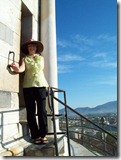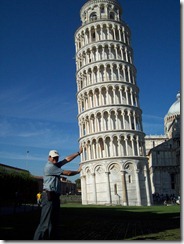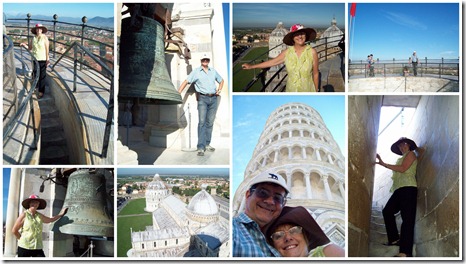Once again we find ourselves staying in a motor caravan car park (EUR 20). One of the advantages is that they are usually close to the main attractions. In this case only a few hundred meters from Pisa’s Cathedral Square. We had been given a tip off that to avoid the tourist rush it is best to be at the tower before 10am. So we emerged from the hymermobile at 9am to a warm sunny day.
We had been given a tip off that to avoid the tourist rush it is best to be at the tower before 10am. So we emerged from the hymermobile at 9am to a warm sunny day.
The other half of the car park we were in is the tourist coach parking area and the first coachloads were already on there way walking past. This was good because unlike our wandering the streets last night this time we followed the mob and they led us through the back entrance to the car park, around a couple of corners and before we knew it we were at the Cathedral Square.
There are limited numbers of people allowed to climb the tower at any one time and you are allocated a timeslot when you purchase a ticket. At 09:30 There was no queue at the ticket window and we could walk over and climb the tower without any waiting.The inside of the tower is a stone 297 step spiral staircase (296 or 294 steps; the seventh floor has two fewer steps on the north-facing staircase) inside leading to the top. The slant is noticeable and the wear on the steps moves (as you do) from the inside to the outside of the steps as you climb. The staircase from the bell chanber to the top is narrow and steep.
The Tower of Pisa is more accurately referred to simply as the bell tower, or campanile. The Pisa tower is one of the four buildings that make up the cathedral complex called Campo dei Miracoli or Piazza dei Miracoli, which means Field of Miracles.
The construction of Tower of Pisa began in August 1173 and the tower began to sink after construction had progressed to the second floor in 1178. This was due to a mere three-metre foundation, set in weak, unstable soil, a design that was flawed from the beginning. Construction was subsequently halted for almost a century, because the Republic of Pisa was almost continually engaged in battles with Genoa, Lucca and Florence. This allowed time for the underlying soil to settle. Otherwise, the tower would almost certainly have toppled.
Click read more below for more and more photos………….
In 1272 construction resumed and in an effort to compensate for the tilt, the engineers built upper floors with one side taller than the other. Because of this, the tower is actually curved. Construction was halted again in 1284, when the Pisans were defeated by the Genoans in the Battle of Meloria.
The seventh floor was completed in 1319. There are seven bells, one for each note of the musical major scale. The largest one was installed in 1655. The bell-chamber was finally added in 1372.
The height of the tower is 55.86 m from the ground on the low side and 56.70 m on the high side. Prior to restoration work performed between 1990 and 2001, the tower leaned at an angle of 5.5 degrees, but the tower now leans at about 3.99 degrees. This means that the top of the tower is displaced horizontally 3.9 metres from where it would be if the structure were perfectly vertical.
Thank goodness Steven managed to push it back upright a little.


